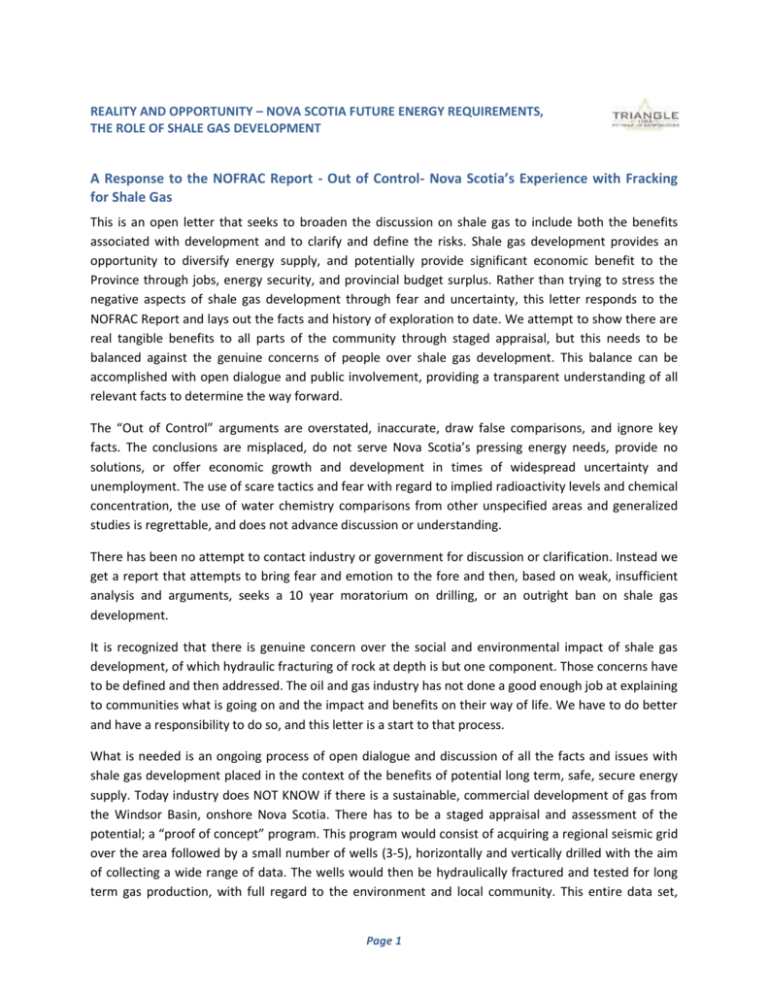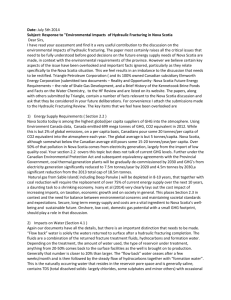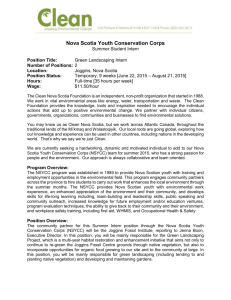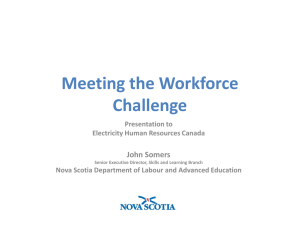Nova Scotia Future Energy Requirements, the Role of Shale Gas
advertisement

REALITY AND OPPORTUNITY – NOVA SCOTIA FUTURE ENERGY REQUIREMENTS, THE ROLE OF SHALE GAS DEVELOPMENT A Response to the NOFRAC Report - Out of Control- Nova Scotia’s Experience with Fracking for Shale Gas This is an open letter that seeks to broaden the discussion on shale gas to include both the benefits associated with development and to clarify and define the risks. Shale gas development provides an opportunity to diversify energy supply, and potentially provide significant economic benefit to the Province through jobs, energy security, and provincial budget surplus. Rather than trying to stress the negative aspects of shale gas development through fear and uncertainty, this letter responds to the NOFRAC Report and lays out the facts and history of exploration to date. We attempt to show there are real tangible benefits to all parts of the community through staged appraisal, but this needs to be balanced against the genuine concerns of people over shale gas development. This balance can be accomplished with open dialogue and public involvement, providing a transparent understanding of all relevant facts to determine the way forward. The “Out of Control” arguments are overstated, inaccurate, draw false comparisons, and ignore key facts. The conclusions are misplaced, do not serve Nova Scotia’s pressing energy needs, provide no solutions, or offer economic growth and development in times of widespread uncertainty and unemployment. The use of scare tactics and fear with regard to implied radioactivity levels and chemical concentration, the use of water chemistry comparisons from other unspecified areas and generalized studies is regrettable, and does not advance discussion or understanding. There has been no attempt to contact industry or government for discussion or clarification. Instead we get a report that attempts to bring fear and emotion to the fore and then, based on weak, insufficient analysis and arguments, seeks a 10 year moratorium on drilling, or an outright ban on shale gas development. It is recognized that there is genuine concern over the social and environmental impact of shale gas development, of which hydraulic fracturing of rock at depth is but one component. Those concerns have to be defined and then addressed. The oil and gas industry has not done a good enough job at explaining to communities what is going on and the impact and benefits on their way of life. We have to do better and have a responsibility to do so, and this letter is a start to that process. What is needed is an ongoing process of open dialogue and discussion of all the facts and issues with shale gas development placed in the context of the benefits of potential long term, safe, secure energy supply. Today industry does NOT KNOW if there is a sustainable, commercial development of gas from the Windsor Basin, onshore Nova Scotia. There has to be a staged appraisal and assessment of the potential; a “proof of concept” program. This program would consist of acquiring a regional seismic grid over the area followed by a small number of wells (3-5), horizontally and vertically drilled with the aim of collecting a wide range of data. The wells would then be hydraulically fractured and tested for long term gas production, with full regard to the environment and local community. This entire data set, Page 1 REALITY AND OPPORTUNITY – NOVA SCOTIA FUTURE ENERGY REQUIREMENTS, THE ROLE OF SHALE GAS DEVELOPMENT along with environmental and societal impact studies will provide sufficient information for a decision on development. If the program is successful, then, in full consultation with government and the public and with agreed environmental safeguards, a long term development project can be put in place and delivered. Not a controversial process of confrontation, waiting on further science or other production history; rather an open, balanced and honest assessment. Then should Nova Scotians find the development unacceptable, it does so knowing the full consequences and cost, and that alternative, realistic energy strategies would need to be found. To respond to the NOFRAC Report we start with the overall energy supply situation in Nova Scotia. Strategically, the Province has stressed the requirement for a long term, stable supply of a mix of energy sources to provide options and diversity, with no reliance on one specific source. Where possible, the supply needs to be under the control of Nova Scotia and offer economic benefit and growth to the Province. This is the context under which onshore shale gas should be assessed. We will then respond to the specific items of the NOFRAC Report – the Triangle Plan, naturally occurring radioactivity (NORM), formation water chemistry, the disposal history of the Kennetcook brine ponds, leaking ponds, missing brine volumes, Windsor disposal, and finally disposal using ice. These topics have all been misinterpreted and incorrectly assessed leading to exaggeration and wrong messages being sent to the public. We also want to comment briefly on the way the Departments of Energy and Environment have acted over the years. The impression imparted in the Out of Control Report, and quoted at the recent meeting in Kennetcook (April 22, 2013) was that regulators were “asleep at the job.” While Triangle has strongly disagreed with Environment in the past, particularly over re-injection of the formation waters, we believe the Departments have at all times been professional and sought to do their job with integrity and in the best interests of the Province. We have respected their role and responsibilities and worked with them these past two years to see the ponds safely drained and the well sites fully remediated to the highest standards and industry best practice. Today we are aligned in our programs and purpose. They have not been “asleep” and the correspondence attests to that, rather they have been active, strong and forthright in their position, allowing dialogue and then together attaining solution to the remediation process. These are complex matters with important outcomes for Nova Scotia, and we believe both Energy and Environment are serving their community to a high standard. Setting of Nova Scotia Energy Requirements Nova Scotia is fast approaching an energy supply dilemma. Based on UN, Environment Canada, and US Department of Energy figures (CDIAC – Carbon Dioxide Information Analysis Center), in 2011 Canada emitted 702 mega tonnes of greenhouse gas (GHG) carbon dioxide (CO2) equivalent. While this is but 2% of global emissions, on a per capita basis this makes Canadians and Nova Scotians some of the worst Page 2 REALITY AND OPPORTUNITY – NOVA SCOTIA FUTURE ENERGY REQUIREMENTS, THE ROLE OF SHALE GAS DEVELOPMENT polluters on earth. Each year, every Nova Scotian pours between 16-20 tonnes of CO2 equivalent into the atmosphere. The global average is but 5 tonnes per capita. Some 50% of that pollution comes from electricity generation, largely from low quality coal imports costing Nova Scotia some $250- 300 million/year. The balance mainly comes from transportation emissions. Today, some 60% of electricity generation comes from imported coal, 20% from natural gas, 10% from hydro/tide and 7% from wind. Nova Scotia has five thermal plants, 33 hydro plants, four combustion turbines, several commercial wind farms and one tidal power plant. See map below (Nova Scotia Department of Energy). The 2009 Climate Change Action Plan put forward absolute caps that will control greenhouse gas emissions in future years, but also sought to increase renewables, improve energy efficiency, improve transmission, encourage emerging technologies and generate more electricity from natural gas. All at an acceptable cost of power to Nova Scotia and an increased security of long term energy supply. From 2015 onwards, the caps apply to limit greenhouse gasses, and from 2020-2030 coal fired thermal stations, will be phased out and decommissioned. While natural gas is not a renewable energy source, it is recognized as a transition fuel to replace coal in the short/medium term. Natural gas generates significanlty less (50-70%) GHG emissions than coal on a combustion basis. The questions become – what replaces coal (60% today) in the Nova Scotia energy mix of the future? Where will the natural gas that is projected to generate +20% of electricity in 2020 going to come from? Page 3 REALITY AND OPPORTUNITY – NOVA SCOTIA FUTURE ENERGY REQUIREMENTS, THE ROLE OF SHALE GAS DEVELOPMENT The current supply of natural gas from offshore Nova Scotia is projected to end in 8-13 years ( Atlantica Centre for Energy-Oct. 2012). From being a major source of electricity and export income over the past 10-15 years, in 2012 only 8% was exported, the rest was consumed in the Maritimes, and the export number is falling. The Deep Panuke Field is due on line in mid-2013. But much of the production is contracted to the energy company Repsol and ear-marked for the Boston and New England markets. There is potential for natural gas from deep water offshore Nova Scotia and several majors – Shell and BP have committed to long term exploration, but first gas in the event of success is decades away. Access to LNG via the Saint John terminal Canaport is limited as shipments are severely curtailed as carriers can achieve far higher landed prices in Europe and Asia rather than North America. It is possible that the existing Maritimes and Northeast Pipeline from Goldboro, Nova Scotia to the eastern US could be reversed and gas made available for an LNG export scheme, as proposed by Pieridae Energy at Goldboro. This could then help Nova Scotia secure its long term gas, however, it will have to pay LNG export price to compete. There was an indication of the future pressure on natural gas prices in Nova Scotia this past winter when prices of +$15 per thousand cubic feet (mscf) were paid to meet a shortfall of gas for electricity generation. Nova Scotia is sitting at the end of a pipeline needing reversal, with dwindling reserves of offshore gas, and currently an extended hydraulic fracturing review process that prevents evaluation of a known, large onshore gas resource. This does not provide a secure, stable, long term supply of natural gas to meet Nova Scotia’s pressing energy requirements. So again the question becomes – what replaces offshore natural gas (20% today) in the energy mix of the future? We contend that to give energy policy makers every option to meet their commitments then Nova Scotia should determine if shale gas development is feasible, commercial and can be socially acceptable. It should answer that question as soon as possible. This requires approving a “proof of concept program” as Triangle has discussed with both Departments of Energy and Environment these past two years. This is the approach being taken by New Brunswick as it progresses its “Responsible Environmental Management of Oil and Gas Activities “initiative issued in May 2012. Details of a program can be prepared, discussed openly and a way forward developed. It will involve a modest regional seismic program over the area, and a three to five well program of both vertical and horizontal wells that will be hydraulically fractured, tested and produced for some months utilizing proven and effective environmental management control to ascertain sustainability of gas production. Evaluation of re-injection of water will be necessary to determine suitability and practicality. The “proof of concept program” can demonstrate that this development can be undertaken in an environmentally responsible and socially acceptable manner. Now to the NOFRAC Report – Out of Control, Nova Scotia’s Experience with Fracking for Shale Gas Page 4 REALITY AND OPPORTUNITY – NOVA SCOTIA FUTURE ENERGY REQUIREMENTS, THE ROLE OF SHALE GAS DEVELOPMENT The Triangle Project Plan The exploration plan described in the NOFRAC Report needs explanation and has to be set in context. The Plan was submitted in September 2008 as a requirement under regulation to request that the Triangle Windsor Basin leases be renewed by the Department of Energy. To go through the necessary approvals, Triangle was asked to submit a Project Proposal that outlined the future work program, reserves potential, infrastructure build up, water availability and disposal, production profile, revenue stream, provincial tax position and environmental impact issues. Job creation was an important aspect, as was timing and financial commitment. These reports are standard practice in the industry and are very much “living documents.” The aim is to provide all parties with an idea of the scope and magnitude of the project and its impact on Nova Scotia. Under no circumstances was this a final, detailed plan document and throughout the text it was emphasized that there will need to be updates, further review, submissions for detailed planning approvals, as well as consultation with local communities and environmental impact studies. It was a “scoping document”. Much has changed in the industry since 2008 and a 230 or even 680 well program would today involve a much smaller footprint in terms of compact well pads, buried flow-lines, less water demand with recycled and purified water use and an improved environmental approach. Since the submission and granting of the Production Lease there continues to be studies and dialogue with the Departments of Energy and Environment. The cessation of drilling and Review on Hydraulic Fracturing has been in place now since June 2011, effectively stopped further work. The cessation was extended in April 2012 indefinitely, with no position expected before 2014. With this in mind, a “proof of concept” program dialogue is proposed that seeks to determine if there is any development potential to access the known 69 trillion cubic feet (TCF) of natural gas resource potential (identified by independent engineers Ryder Scott) that sits in the Windsor Basin. If this were even in part realized, the resource is staggering in its size, and would be enough to supply Nova Scotia current needs for many generations. It would revitalize the Nova Scotia economy, bring government finances to surplus, provide thousands of direct and indirect jobs, and permit export by either pipeline or LNG facility. These are the potential benefits that NOFRAC ignores and offers no alternative to energy supply. Isn’t the idea of shale gas in Nova Scotia at least worth exploring if it can be done in an environmentally responsible manner? Any development would only occur if acceptable to Nova Scotia and local communities, and the “issues” raised by NOFRAC discussed and resolved. We know that good technical solutions are available to manage environmental risk. The following pictures illustrate the small footprint that can be established at a production site: Page 5 REALITY AND OPPORTUNITY – NOVA SCOTIA FUTURE ENERGY REQUIREMENTS, THE ROLE OF SHALE GAS DEVELOPMENT A 6 Well Pad in the Marcellus in Pennsylvania- flow-lines are buried, carrying produced water, gas and natural gas liquids (NGL’s) to Gas Plants and export pipelines. A small footprint, with no flare and limited use of trucking to service the site. An individual well pad – Marcellus Gas Play – Pennsylvania – note the protected storage tanks. The wells are monitored remotely, powered by solar panel, with a separator to pass NGL’s and water to storage and gas to a buried line. The footprint is small, no gas is flared and trucking limited. Page 6 REALITY AND OPPORTUNITY – NOVA SCOTIA FUTURE ENERGY REQUIREMENTS, THE ROLE OF SHALE GAS DEVELOPMENT Naturally Occurring Radioactive Materials - “NORMS” Much is made in the NOFRAC report of the lack of NORM measurement from 2008-11, and of the readings taken since October 2011 resulting in special treatment before disposal. Let us be clear….there is no threat to the population in any shape or form from the NORM levels recorded from the ponds. Radioactivity levels have to be placed in context, and not left as statements saying that the pond waters contain “elements having long half-lives and known health risks.” This is misleading and scaremongering. Radioactivity is a complex, natural phenomenon occurring in most ancient rocks, and typically found across Nova Scotia. We live with it every day and are surrounded by it from buildings, concrete and everyday objects. For example, sea water has an average naturally occurring radioactivity of 13 Becquerel per Liter (Bq/L), while pond radioactivity at the Kennetcook site ranged from 2 to 35 Bq/L. A human adult has an average radioactivity of 100 Bq/kg and bananas, 130 Bq/kg. Becquerel’s are the unit for radioactivity intensity measurement where one Becquerel is one radioactive decay per second. Health Canada (HC) puts out a series of conservative guidelines for NORM to safeguard the public from any excessive exposure. HC identified guideline limits for material to be released to the environment without further control is based on an appropriate dose value. This dose is calculated from the total effect of differing types of radiation on different parts of the body giving an additional total exposure of 0.3 milli Sieverts (mSv) or less per year. It is noted that the background average for Canadians is approximately 2.0 mSv per year with a range from 1.2 to 3.2 mSv per year. Where this exposure is not exceeded, the NORM is unrestricted, i.e., does not constitute a risk or hazard to humans and requires no further action for control. These guideline limits are identified as Unconditional Derived Release Limits (UDRL) by HC. The HC dose guidelines (UDRL limits) are more stringent for waters (aqueous solutions) assuming drinking water ingestion, as this is the most sensitive pathway for humans. The standards adopted by Environment for the Kennetcook pond water were for the most stringent HC UDRL guideline’s for human exposure, even though no drinking water pathway was present. The radioactivity measured in the Kennetcook ponds is contained in the total dissolved/suspended solids in the brines that were drawn from the rock formations following the testing of the Kennetcook wells. The pond water has stratified (less saline water floats on top of more saline water) as the surface has been diluted with rainfall while more saline/dense water remains at the bottom. The samples tested in the upper section of the ponds were below UDRL limits for NORM and thus suitable for unconditional release based on HC guidelines for natural radioactivity. It was only in the deeper samples that had slight exceedances of UDRL guideline limits for aqueous solutions with potential for the water to enter a drinking water supply with less than 10 fold dilution. Regardless of the treatment destination for the pond water, no discharge to drinking water sources was ever contemplated, permitted or undertaken. Given that the pond brines are not going near drinking water pathways and are to be treated before ultimate discharge to the marine environment, there is no risk of unacceptable ingestion. Page 7 REALITY AND OPPORTUNITY – NOVA SCOTIA FUTURE ENERGY REQUIREMENTS, THE ROLE OF SHALE GAS DEVELOPMENT Radium 226, the key identified radionuclide in the pond water predominantly emits 96% alpha radiation that fail to penetrate skin or air. So to fall into any unacceptable exposure scenario, a person would need to drink a huge amount of the brine pond constantly over a long period of time (years) to expose themselves to any unacceptable level of radioactivity. However, in an abundance of caution, the Department of Environment currently requires us to meet the HC aqueous UDRLs prior to discharge of any waters. Triangle devised filter methods by which the NORM could be removed, and the resultant filtered waters were retested to ensure the NORM’s were reduced to below UDRL levels. This we have done to the satisfaction of independent and certified laboratories and the Department of Environment. The levels of NORM identified for the pond waters pose no unacceptable exposure to humans. However we are happy to work with the Department of the Environment and deliver standards at the more stringent HC aqueous level. On approval from the Department of Environment using the proven treatment process we propose to complete the treatment of the current pond waters and discharge water meeting limits set to protect humans and the environment at an approved location on agreement with the municipal authorities. In summary, NORMs were sampled at the request of Department of Environment and we now have incorporated the process into our protocols for any future drilling or discharge. The results of testing have shown NORM to be minor in amount. The pond waters are being discharged through a treatment facility, in the same fashion as wastes from sinks and toilets. Litres per day of untreated wastewater would need to be ingested by individuals continuously over years to cause any concern related to additional radiation exposure. Water Chemistry and Discharge History Again the content of the ponds and their history needs to be described and understood. It is incorrect and unacceptable to cast the ponds as wastewater that is full of untested chemicals and contaminants. Detailed analyses of all the chemicals used were made available at the time of operations and the waters tested frequently ever since. The analogy with frack waters elsewhere that are loaded with unspecified, harmful, dangerous and long lasting chemicals is incorrect. Again no facts from Kennetcook project were provided by the authors of the NOFRAC Report to back up these unsubstantiated claims. The Kennetcook #1 and #2 wells were drilled as vertical wells back in 2007. An additional well was also fracked, but failed to bring any fluids to surface The completion that took place was a simple, two stage slickwater fracture stimulation, over very restricted 5-10 m intervals below 1300 m depth and used the following: Page 8 REALITY AND OPPORTUNITY – NOVA SCOTIA FUTURE ENERGY REQUIREMENTS, THE ROLE OF SHALE GAS DEVELOPMENT Kennetcook #1 5,578 cu.M of fresh water 304 tonnes of Ottawa Sand Kennetcook #2 4,767 cu. M of fresh water 301 tonnes of Ottawa Sand 1,374 litres of B4 surfactant 2,789 litres of AG-59L friction reducer 2,623 litres B4 surfactant 4,767 litres of AG-59L friction reducer N-14A #1 2,429 cu.M of fresh water 200 tonnes of Ottawa Sand 237 cu.M of CO2 4,557 litres of Inflo surfactant 2,278 litres of AG-59L friction reducer The surfactant and friction reducers (sophisticated detergents) are used to improve injection into the rock formation and were minor in amount, less than 0.001% of the total fluids. The chemicals used were made available to Departments of Energy and Environment. Proprietary (i.e., non-disclosed) fracking chemicals were not used. Less than 5% of the volume of chemicals inferred by the NOFRAC Report was used. Further, it is a distortion and misinterpretation to imply human contact and consumption of the fracking chemicals and so define them as carcinogens and mutagens. These same materials are in your yard (sand), under your kitchen sink and used for daily in-house cleaning. Many of the chemical hazards associated with the chemicals are misrepresented as the dry powered form of any chemical represents an inhalation hazard or potential eye irritant. The pond waters are not in powder form for human ingestion, and will be treated meeting environmental and human health limits and discharged with no contact to drinking water. The fresh water was pumped into the lined ponds from the nearby rivers, each pond with a total capacity of 10 million litres. The fracture stimulations were completed and no gas returned to surface. To stimulate the rock to potentially free gas, pumping was applied and formation water flowed to surface in both the Kennetcook wells, but the N14A well was abandoned with no flow and remaining waters returned to Kennetcook #2. The hope was that in time the water production would be replaced by gas, but this did not happen and the Kennetcook tests were terminated. Approval was granted by the Department of Environment to use the lined fresh water ponds to contain the produced formation water/returned flow-back water. It is not known exactly how much formation water was produced, or how much slickwater was returned, but both ponds were each roughly half full, so 5 to 6,000 cubic metres (cuM) in each is a reasonable estimate. The formation water chemistry has been analyzed consistently and repeatedly over the years and it is shown to predominantly contain high levels of chlorides (salts) that are being gradually diluted by rainwater. At 25-40,000 mg/L chlorides currently at the base of the ponds, this is corresponds to a salinity range approximately double the salinity of ocean salt water. The following table shows additional chloride results to that provided by NOFRAC. Page 9 REALITY AND OPPORTUNITY – NOVA SCOTIA FUTURE ENERGY REQUIREMENTS, THE ROLE OF SHALE GAS DEVELOPMENT Sample Location KC-1 Surface KC-1 Mid KC-1 Deep Sample Location KC-2 Surface KC-2 Mid KC-2 Deep March 11, 2008 24,000 - March 11, 2008 23,000 - KC-1. Comparison of Chloride Concentrations (mg/L) September October 8, April 26, October 24, 2009 2010 2011 18, 2011 25,000 15,000 8,400 9,000 - 21,000 37,000 12,000 33,000 17,000 KC-2. Comparison of Chloride Concentrations (mg/L) September October 8, April 26, October 24, 2009 2010 2011 18, 2011 7,800 9,100 4,300 7,100 - 53,000 57,000 27,000 54,000 38,000 Jan. 14, 2012 8,600 8,800 8,400 22,000 17,000 21,000 May 1, 2012 5600 Jan. 13 and 14, 2012 6,900 8,300 6,800 39,000 29,000 15,000 May 1, 2012 5200 5200 - - During this time, chemical sampling and analysis has taken place and continues to occur on a regular basis. Pond water sampling included an extensive suite of chemical analyses - general parameters, metals parameters, hydrocarbons, Polycyclic-aromatic hydrocarbons (PAHs) and Volatile Organic Carbon parameters (VOC)s. This analysis was conducted by a certified laboratory and part of the laboratory protocol is notification of the presence of detectable unknown chemicals not specifically targeted in analysis – the analysis did not identify any chemical spikes or presence of unidentifiable chemicals. The organic additives used in the fracking are readily naturally degradable and although PAHs and some light end petroleum hydrocarbon compounds were detected at low levels (below guidelines for humans or aquatic life) in 2008, sampling of pond waters from 2011 to present has not detected these constituents. Recent chemical analyses has not identified any significant concentrations of potential contaminants with guideline limits other than chloride and minor exceedances of the UDRL guideline limits for select NORM isotopes. Pond Leaking Rainwater/snow/ice has added to the ponds since 2008. The brines have been diluted and over time stratified such that the surface waters, as shown by chemical analysis are nearly fresh water. The pond lining has retained its integrity although what could have been a small liner leak in the upper portion of the liner was identified at Kennetcook #1 in May 2011. On agreement with the Department of Environment, the pond level was lowered to below the level of the leak and has been maintained at that low level prior to freeze-up. The ponds are inspected regularly and safe freeboard water levels Page 10 REALITY AND OPPORTUNITY – NOVA SCOTIA FUTURE ENERGY REQUIREMENTS, THE ROLE OF SHALE GAS DEVELOPMENT maintained to prevent over-spillage. Soil samples have been tested from around the pond for NORM both by the Department of the Environment and Triangle and were below UDRL with levels consistent with typical soil ranges (i.e., no indication of any form of contamination). Missing Wastewater/Windsor Treatment and Disposal Rainwater/snow/ice is estimated to have added 1 m/year to the ponds and this works out at some 3 million litres per year/pond. Triangle has worked with the Department of Environment to maintain freeboard (i.e., keeping the water level below spillway height). Since 2008, the ponds have remained and brines have been repeatedly withdrawn with required approvals to ensure no overspill. To date $1.9 million has been spent on brine disposal from the ponds. For NOFRAC to say there is missing wastewater is again scaremongering; all volumes were monitored with full knowledge of benign chemistry and good processing and safe discharge. Atlantic Industrial Services (AIS) have been our service provider for the past five years. AIS is very experienced in appropriate handling, transport, treatment, disposal and discharge of various industrial waste waters and other wastes. Their facilities have a wide variety of treatment capabilities and AIS is one of the most capable waste water treatment companies in Canada with over a dozen different technologies at its facilities. AIS have demonstrated their ability to treat the pond waters to meet environmental quality requirements. There have been no incidents or upsets and AIS and the Municipality of Colchester have full knowledge of all chemicals involved. AIS use several steps to ensure it meets its discharge criteria before release of the final effluent. The ability to treat the Kennetcook pond water has been shown at both lab scale conditions and large scale volumes. Some Kennetcook brines were taken to the Windsor sewerage system with Department of Environment approval. The water chemistry met environmental requirements for provincial discharge. It is incorrect of NOFRAC to say the Windsor or Debert wastewater plants are unable to accept the brine. The brine water was managed in a manner that was protective of wastewater treatment capacity and, as noted in discussing the chemicals and NORM constituents, did not represent a hazard to humans or the environment. Frozen Wastewater Melted On Site Over the years, many options have been considered to drain the ponds. These included, 1. 2. 3. 4. 5. 6. Building a tent over the ponds to keep the rain out and then truck away the brines; Setting up jets in the ponds to cause evaporation; Take the ice from the ponds and melt it on the well-site; Pump the brines away directly to the ocean by temporary pipeline; Use the brines for grit and/snow/ice melt on roads; or Re-inject into the formation whence it came. Page 11 REALITY AND OPPORTUNITY – NOVA SCOTIA FUTURE ENERGY REQUIREMENTS, THE ROLE OF SHALE GAS DEVELOPMENT None of the above was adopted as they were impractical, too costly, or unacceptable to the Department of Environment or Triangle. A formal approval was granted for the freeze thaw proposal; however, that was not implemented as it was thought it would damage the liners and was felt to be not practical or appropriate. Conclusions This response seeks to stop the claim/counterclaim approach to any identified issue. The facts should be gathered, reviewed by all and a common approach taken in full context both of the environment and energy future of Nova Scotia, together the development of the provincial economy. NOFRAC has concluded that fracking wastewater is a problem without a solution. We have demonstrated that technologically feasible solutions are in place. A treatment for NORM has been developed, with acceptable discharge criteria. In addition, we believe that the practical solution of reinjection of formation waters to where they originated should be further evaluated. It is best practice in Canada and most all other areas where shale development takes place. The geology is favorable, and the aquifers separated from the gas bearing intervals by over 1000 metres of rock including an impermeable salt section. The well designs have five layers of separation of steel casings and cements from the production casing carrying the gas and/or formation water. This makes any aquifer contamination all but impossible. It is the contention of Triangle that a “proof of concept” program be put together to see if there is any shale gas development potential. The program should be openly discussed and pay special attention to the concerns of the local communities. This way, a phased approach is taken and much can be learned and confidence grown to determine if shale development is sustainable, economic and environmentally acceptable. Triangle is happy to make all data available to any party, so long as they agree to discuss their views and findings in an open minded way seeking to find solutions and progress the growth of Nova Scotia. Respectfully Dr. Peter J. Hill Chairman, Triangle Petroleum Corporation Page 12






